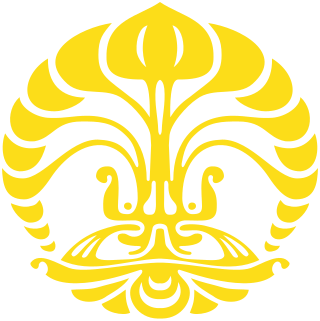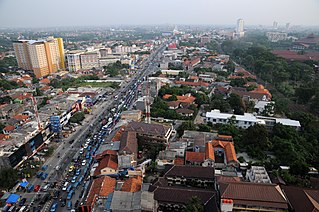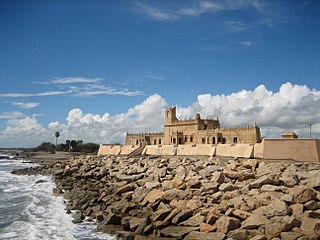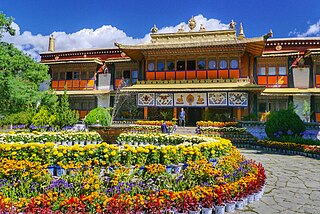Related Research Articles

The University of Indonesia is a public university in Depok, West Java and Salemba, Jakarta, Indonesia. It is one of the oldest tertiary-level educational institutions in Indonesia, and is generally considered one of the most prestigious universities in Indonesia, along with the Gadjah Mada University and Bandung Institute of Technology. In the 2024 QS World Universities Ranking, UI is ranked 1st in Indonesia, 49th in Asia and 237th in the world.

Depok is a landlocked city in West Java province. It is located directly south of Jakarta within the Jakarta Metropolitan Area in Indonesia. It has an area of 199.91 km2. It had a population of 1,738,600 at the 2010 census and 2,056,400 at the 2020 census; the official estimate as at mid 2022 was 2,123,349, resulting in a density of 10,621.5 people per km2. Depok was declared as a separate city on 20 April 1999, having previously been part of Bogor Regency. It constitutes the second most populous suburban city in Indonesia, and the tenth most populous suburban city globally.

The culture of Indonesia has been shaped by long interaction between original indigenous customs and multiple foreign influences. Indonesia is centrally-located along ancient trading routes between the Far East, South Asia and the Middle East, resulting in many cultural practices being strongly influenced by a multitude of religions, including Buddhism, Christianity, Confucianism, Hinduism, and Islam, all strong in the major trading cities. The result is a complex cultural mixture, often different from the original indigenous cultures.
Hidayatullah is an Islamic mass organization based in Indonesia, founded in 1973. It is aimed at propagation of puritanical interpretation of Islam, and dawah (proselytization). The organization operates pesantren, mass media, women's division, and coop.

Colonial architecture is a hybrid architectural style that arose as colonists combined architectural styles from their country of origin with design characteristics of the settled country. Colonists frequently built houses and buildings in a style that was familiar to them but with local characteristics more suited to their new climate.

Bekasi is a city in West Java, Indonesia, located on the eastern border of Jakarta. It serves as a commuter city within the Jakarta metropolitan area. According to the 2020 Census by Statistics Indonesia (BPS), Bekasi had 2,543,676 inhabitants. The official estimate for mid 2022 was 2,590,257. It lies within the largest metropolitan area in Indonesia (Jabodetabek). The city is bordered by Bekasi Regency to the north and the east, Bogor Regency and Depok City to the south, and East Jakarta to the west.

Old Banten is an archaeological site in the northern coast of Serang Regency, Banten, Indonesia. Located 11 km north of Serang city, the site of Old Banten contains the ruin of the walled port city of Banten, the 16th-century capital of the Sultanate of Banten.

Norbulingka is a palace and surrounding park in Lhasa, Tibet, built from 1755. It served as the traditional summer residence of the successive Dalai Lamas from the 1780s up until the 14th Dalai Lama's exile in 1959. Part of the "Historic Ensemble of the Potala Palace", Norbulingka is recognized as a UNESCO World Heritage Site, and was added as an extension of this Historic Ensemble in 2001. It was built by the 7th Dalai Lama and served both as administrative centre and religious centre. It is a unique representation of Tibetan palace architecture.

Menteng is a district in the administrative city of Central Jakarta, Indonesia. Menteng is surrounded by the districts of Senen and Matraman to the east, Tebet and Setiabudi to the south, Tanah Abang to the west, and Gambir to the north. Menteng is bound by the West Flood Canal to the west, Ciliwung River to the south and east, and Kebon Sirih Road to the north. Menteng is the district seat of the Central Jakarta government.

There are 1,340 recognised ethnic groups in Indonesia. The vast majority of those belong to the Austronesian peoples, with a sizeable minority being Melanesians. Indonesia has the world's largest number of Austronesians and Melanesians.

The National Museum of Indonesia is an archeological, historical, ethnological, and geographical museum located in Jalan Medan Merdeka Barat, Central Jakarta, right on the west side of Merdeka Square. Popularly known as the Elephant Museum after the elephant statue in its forecourt, its broad collections cover all of Indonesia's territory and almost all of its history. The museum has endeavoured to preserve Indonesia's heritage for two centuries.

Dutch colonial architecture refers to the various style of Dutch architecture built across the Dutch Empire. Though most of the buildings were designed by Dutch architects and dictated by Western architectural styles, even the most ardent style-purists among architects could not escape the forces of context and culture. Dutch colonial architecture often is a result of climatological adaptations or the use of local building materials - and more importantly, the rich and diverse cultural contexts. In this hybridity lies the quality of these buildings. Architecture shows that the strict racial taxonomy of a colonial system could not be maintained.

Cultural properties of Indonesia are those items defined by Indonesian law as of "important value for history, science, and culture", and include both man-made artefacts and natural objects. The cultural properties number more than 8,000 and include ancient Hindu and Buddhist temples, mosques, historic colonial buildings, forts, art galleries, national parks and beaches. A number of the sites are World Heritage Sites.

Depok Station (DP) is a railway station located in Pancoran Mas, Pancoran Mas, Depok, West Java. This station is commonly known as Depok Lama, to distinguish with Depok Baru Station. The station is one of the oldest station in Jakarta metropolitan area. At present it serves as a station of Jakarta Commuter Rail. Depok EMU depot is located to the southwest of the station.

Kampung Cina, is a Chinatown located in Kuala Terengganu, Terengganu, Malaysia. Kampung Cina is located along Jalan Bandar, in Kuala Terengganu city centre at the river mouth of Terengganu River that empties into the South China Sea. Kampung Cina literally means Chinese Village; it is also called Tn̂g-lâng-pho (唐人坡) or KT's Chinatown by local people. It is one of Southeast Asia's early Chinese settlements and contains stately ancestral homes, temples, townhouses, and business establishments. The town is small but has colourful shophouses along both sides of the road that carries traditional flavour.

Palembang, Palembangs, or Palembangese are one of the indigenous Sumatrans native to the southeastern Sumatra regions of Palembang in Indonesia. There are approximately 3,800,000 native Palembang living in regions across Indonesia, and there are about 30,000 Palembang diaspora living outside of Indonesia, mainly in Singapore.
Pondok Modern Darussalam Gontor Ponorogo, also known as Pondok Modern Gontor, abbreviated as PMDG, or simply Pesantren Gontor, is a pesantren in Ponorogo Regency, East Java, Indonesia. Since its founding in 1926, the pesantren has become famous for the application of discipline, heavy emphasis on foreign languages, and strong network and cadre of alumni. It also has been an educational institution known for not being specifically tied to any political and social organization. The pesantren is considered the backbone of Muslim society in Indonesia, producing numerous leading figures in the history of Islam in Indonesia.
Cornelis Chastelein, also written Chasteleijn or Chastelijn was born of a notable merchant family. He was the youngest member of a family of eight children. His father, Anthony Chastelein, arrived to the Netherlands from France as a huguenot, and a member of the Dutch East India Company. His mother, Maria Cruydenier, was the daughter of the mayor of Dordrecht who served for the Dutch West India Company.
Royal Ambarrukmo is a luxury hotel located in Sleman Regency, Yogyakarta, Indonesia. The hotel was built as directed by Indonesian President Sukarno in 1964, alongside Jakarta's Hotel Indonesia, Pelabuhan Ratu's Hotel Samudera, and Bali's Bali Beach Hotel. The hotel was built on the site of the former Ambarrukmo Palace, a 19th-century royal residence of the Yogyakarta Sultanate, from which the hotel derives its name. The buildings of the former palace still stands and is now housed within the hotel compound.
References
- ↑ "Instansi Kelurahan". Archived from the original on 2014-03-31. Retrieved 2014-05-15.
- 1 2 3 (in Indonesian)Jonathans, Yano. 2011. Potret Sosial dan Budaya Masyarakat Depok Tempo Doeloe. Jakarta: Libri.
- ↑ Joseph, Renold. On Interview With the Writer. Depok, Indonesia, 25 December.
- ↑ "The History of Depok Lama".
- ↑ Lukman, Alqiz; Assilmi, Ghilman; Imandiharja, Ide Nada (1 June 2020). "Cultural Heritage Digitization in Indonesia: A New Perspective on Preserving Depok Colonial Heritage". Kapata Arkeologi. 15 (1): 15–24. doi: 10.24832/kapata.v15i1.15-24 . S2CID 223320297.